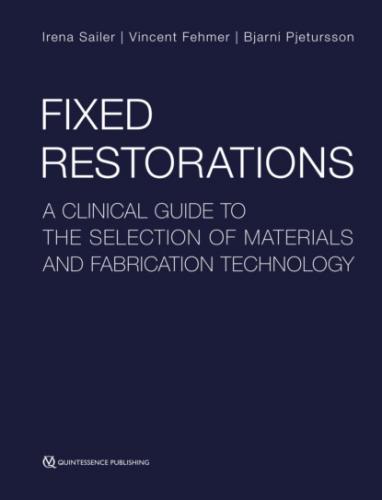Fixed Restorations. Irena Sailer
Part III Long-term outcomes of fixed restorations
3.1 Introduction
3.2 Tooth-supported veneers
3.3 Tooth-supported inlays and onlays
3.4 Tooth-supported SCs
3.5 Endocrowns
3.6 Tooth-supported conventional multiple-unit FDPs
3.7 Tooth-supported cantilever FDPs
3.8 Resin-bonded fixed dental prostheses (RBFDPs)
3.9 Implant-supported SCs
3.10 Implant-supported FDPs
3.11 Implant-supported cantilever FDPs 693
3.12 Combined tooth-implant-supported FDPs
3.13 References
Part IV Avoiding and managing complications
4.1 Introduction
4.2 Success of tooth- and implant-supported restorations
4.3 Tooth-supported restorations
4.4 Implant-supported restorations
4.5 References
In this chapter:
■ Requirements for restorative materials
■ Overview of current materials for fixed restorations
■ Conclusions
In the past, material selection in fixed prosthodontics was mainly based on metal-ceramics and on a few all-ceramic alternatives. Metal-ceramic restorations were selected in clinical situations with need for high stability (eg, in the posterior region or in the case of multiple-unit fixed dental prostheses), whereas all-ceramic restorations were recommended in single tooth replacement with high esthetic demands, especially in the anterior region. These materials were traditionally processed by manual fabrication technologies such as casting, pressing, or layering1,2. Restorative dentistry with all-ceramic restorations has suffered from a prolonged learning curve. Several of the early systems disappeared shortly after being introduced due to an unacceptable number of mechanical failures3.
Nowadays, clinicians and technicians can choose from a wide range of reliable materials. Digital technologies such as intraoral optical scans and computer-aided design/computer-aided manufacturing (CAD/CAM) procedures have opened up new treatment pathways in fixed prosthodontics. New digital fabrication workflows were defined and in parallel advanced materials were developed and adjusted to the specific requirements of numerically controlled processing such as high-strength ceramics and composites. In these digital workflows, the restorations are fabricated by means of computer-aided milling from prefabricated blanks, increasingly replacing conventional manual processing.
The different materials available today exhibit differences in properties, influencing the esthetics and the long-term performance of the restorations. As multiple alternatives exist for each clinical situation, it is more difficult to select the most appropriate material for the respective clinical situation today than in the past4–6. As a consequence of the transformation in present technology, selection of the restorative material requires understanding of the interaction between material properties and clinical performance7.
After an introduction to the requirements for restorative materials and the behavior of the different material classes used in dentistry, this Chapter will provide an overview of the current material options for fixed restorations and their clinically relevant properties, indications, and limitations.
1.1.2 Requirements for restorative materials
In the oral cavity, restorative materials have to meet three requirements: biocompatibility, longevity, and esthetics.
Biocompatibility
The term biocompatibility implies that the material shall do no harm to the living tissues, achieved through chemical and biological inertness8. As every material potentially dilutes or degrades depending on the environment, the extent of decomposition, and the quality and amount of released substances determine the degree of biological complications. A possible host response might be localized or systemic toxicity, hypersensitivity, or genotoxicity9. The restriction to biocompatible components strongly limits the room for the development of new materials.
Due to the strict regulations for medical devices, manufacturers have to prove biocompatibility of their materials. International standards help the choosing of the appropriate tests and in interpreting the results. Tests must be done with every novel material prior to approval. Biological tests are employed in a sequence, ending up with animal tests9. Furthermore, manufacturers of medical devices are forced by law to perform a systematic post market surveillance of the materials and devices. Measures have to be taken to minimize risk and unexpected side effects must be notified to the authorities. Fortunately, it can be concluded that biological and immunological adverse reactions attributed to dental materials are rare and the reported adverse effects are acceptable9.
On the other hand it is unrealistic to assume that absolute material inertness is attainable and biological behavior is definitely predictable by means of biological tests10. Hence, the biocompatibility of dental materials must always be weighed against their benefit11. Controlled clinical trials are currently still the best way to assess the clinical response to materials. But even these tests have significant limitations. Therefore, practice-based research networks and practitioner databases are increasingly considered as a valuable alternative10.
Longevity
The long-term success of a restoration mainly depends on its mechanical performance. From the technical side the success of a restoration can be controlled by the durability of the material, the nature of the design, the quality of the processing, and the effectiveness of the finishing.
Material
The mechanical behavior of dental materials is
